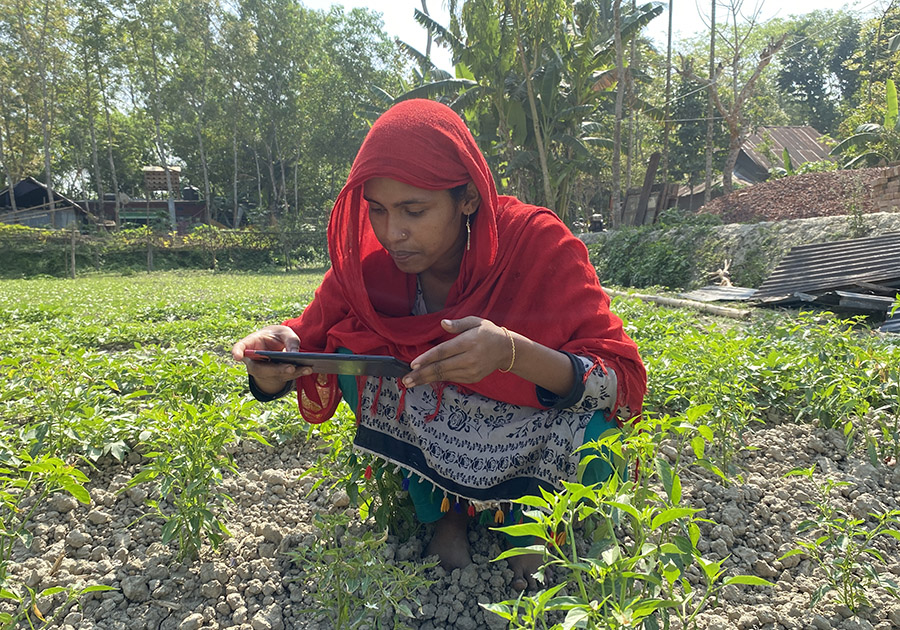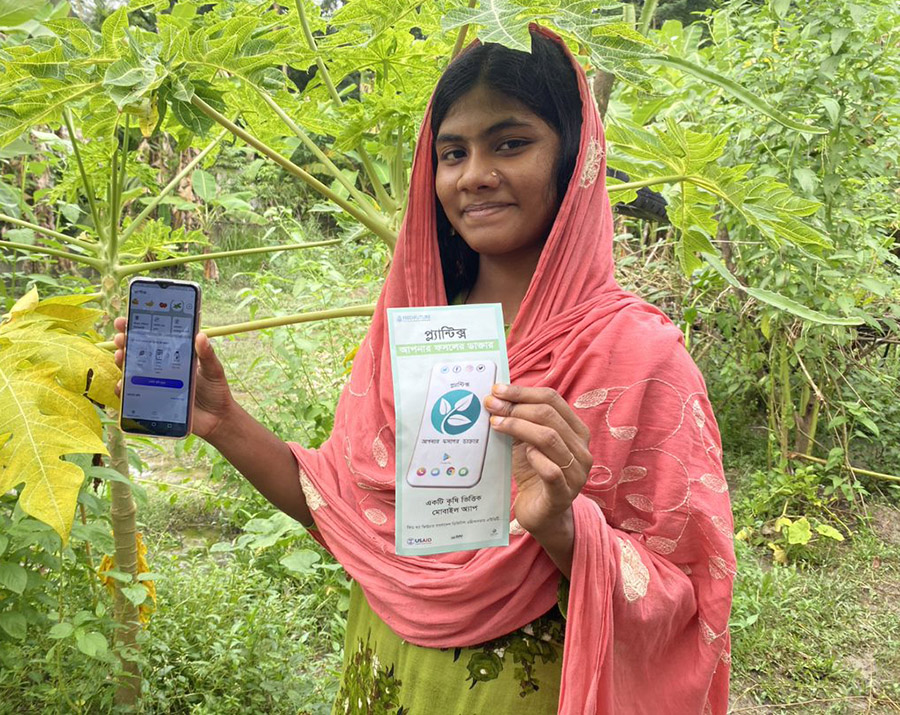Let us know what type of content you'd like to see more of. Fill out our three question survey.
Lessons Learned in Bangladesh: Engaging Women in Digital Agriculture Tools
Apr 12, 2023
The role of women in agriculture is crucial, especially in countries such as Bangladesh where they make up almost half of the sector’s labor force. However, women often have limited access to resources and assets that could improve their livelihoods, including information that can be accessed through technology.
Digital agriculture tools, such as mobile apps and texting services, can help overcome the information disparity between men and women. But first, it is essential to understand the unique challenges that women face in agriculture and how digital tools can address those challenges. Women often have limited access to land, capital, and information, which hinders their participation. Moreover, they have limited mobility, which makes it difficult for them to physically access markets and other agricultural services.

Photo: BDAA.
The Feed the Future Bangladesh Digital Agriculture Activity (BDAA) is a program implemented by DAI’s Digital Frontiers project that promotes the use of digital tools and technologies to bolster the expertise of farmers, retailers, and service providers in the agricultural industry in Bangladesh. BDAA identifies and selects potentially effective digital agricultural tools and deploys them in collaboration with other Feed the Future partners, tool owners, and relevant private-sector actors.
While integrating women into BDAA’s work—including all pilots or testing activities—is a key requirement of the team’s, assessing the true nature of including women in tool design and achieving real inclusion during project implementation remains a challenge.

Photo: BDAA.
Pilots: What Works and What Doesn’t Work
One tool piloted by BDAA is Plantix, a mobile crop advisory application that can help overcome information gaps and disparities for women. The tool identifies issues associated with crop production and offers solutions, giving farming tips and weather information. The pilot was conducted with 260 farmers and industry actors in seven districts of Bangladesh. Our results showed that women who used Plantix were able to make better-informed decisions about their crops, which led to the women having more status and voice within their families and communities.
Despite the tool’s clear benefit, only 14 women participated in the pilot. The BDAA team struggled to enroll women farmers due to many women not owning smartphones, having limited digital and traditional literacy, or simply unwilling to use digital tools. Even worse, as one of the goals was to engage agro-input retailers, the BDAA team only found one woman able to participate.
The scarcity of women contract growers in Bangladesh is also a significant challenge, despite the presence of women farmers and their involvement in contract farming processes. When piloting a tool called SHUFOLA, which provides weather-based agricultural advisory to farmers in Bangladesh, only 152 out of the 500 participating farmers were women. While the tool has immense potential to address the mobility barriers faced by women in agriculture, it was observed that fewer female participants could comprehend the messages compared to their male counterparts, primarily due to low education. With only around 12 percent of the women having no formal education, and most completing only primary and secondary schooling, their understanding of the tool’s potential was limited.

Photo: BDAA.
Factors to Consider
So, how do we design more interventions considering women’s needs, and ultimately encouraging women to adopt these tools? Designing digital agricultural interventions for women requires a holistic understanding of their needs, socio-economic barriers, and their unique preferences. Here are some factors to consider:
- Language and literacy: During the pilots, we observed that women were less inclined to use technology in general, due to a lack of ownership and limited literacy. Interventions should aim to lower the barriers to use of tools, and design tools with simple and easy-to-understand language, and with features that make it accessible to women with varying levels of traditional and digital literacy. The importance of education and literacy was highlighted for Plantix, where it was observed that most of the women participants finished secondary higher education, while the male farmers and other value chain actors had bachelor’s degrees. Similar findings were observed for SHUFOLA, where it was noted that around 12 percent of the female participants had no formal education, compared to 10 percent of the male participants. This also made it difficult for them to navigate the tools, resulting in less impact and benefits for them compared to their male counterparts.
- Local customs and context in the design process: The tools should be designed with a deep understanding of the cultural norms, gender roles, and socio-economic factors that may impact women’s participation in agriculture. Women farmers who participated in the SHUFOLA pilot faced a significant challenge with the timing of weather-based advisory text and outbound dialing messages, as they received them just before evening prayer time in Ramadan while they were busy preparing iftar. These findings underscore the need for interventions to engage with women farmers and understand their needs and constraints to ensure that the tools are effective and accessible for all.
- User-centered design and simpler user interface: It’s essential to involve women in the design process to ensure that the application meets their specific needs and preferences, underscored in our SHUFOLA pilot. Conducting user research and testing can help to identify user requirements and preferences and ensure that the application is usable and effective. When designing an agriculture application, it is important to even look at smaller things such as the size and the placement of a button. For instance, design principles suggest that making a button bigger than 40 pixels is more inclusive to women as women tend to have longer fingernails than their male counterparts.
Designing digital agricultural interventions for women requires a deep understanding of their unique needs, socio-economic barriers, and preferences. Gender inclusion approaches should be core considerations in the design process, as well as during project implementation. While digital tools such as Plantix and SHUFOLA have clear advantages and benefits to their users, women’s limited access to technology, education, and digital literacy continues to be a significant challenge. Language and literacy, local customs and context, and access to technology are some of the factors to consider while designing interventions. By overcoming these challenges, digital agricultural interventions can help improve the livelihoods of women.
Tasnuba Sinha is a development professional who focuses on digital inclusion and works for the Bangladesh Digital Agriculture Activity implemented by DAI.